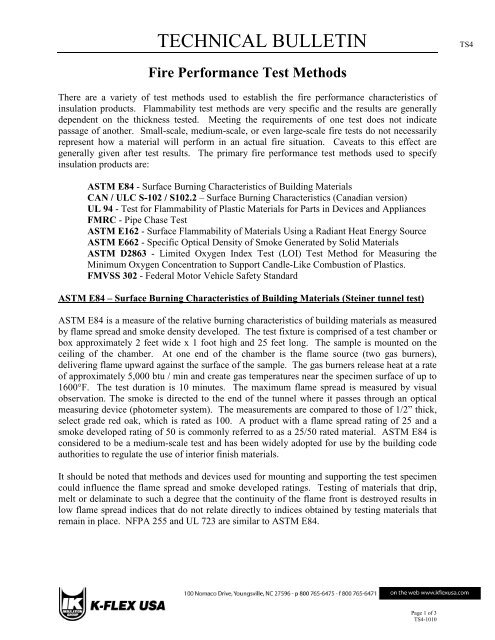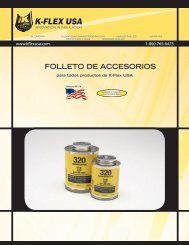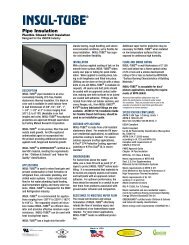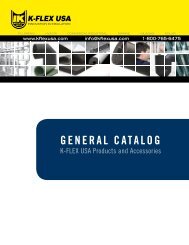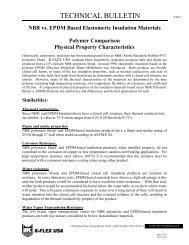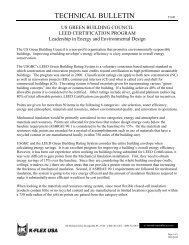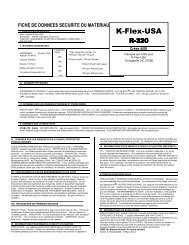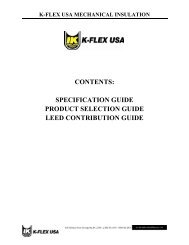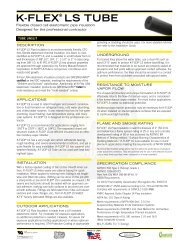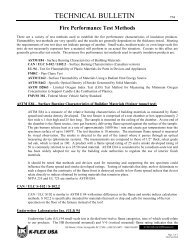TS04 Fire Performance Test Methods - K-Flex USA
TS04 Fire Performance Test Methods - K-Flex USA
TS04 Fire Performance Test Methods - K-Flex USA
Create successful ePaper yourself
Turn your PDF publications into a flip-book with our unique Google optimized e-Paper software.
TECHNICAL BULLETIN TS4<strong>Fire</strong> <strong>Performance</strong> <strong>Test</strong> <strong>Methods</strong>There are a variety of test methods used to establish the fire performance characteristics ofinsulation products. Flammability test methods are very specific and the results are generallydependent on the thickness tested. Meeting the requirements of one test does not indicatepassage of another. Small-scale, medium-scale, or even large-scale fire tests do not necessarilyrepresent how a material will perform in an actual fire situation. Caveats to this effect aregenerally given after test results. The primary fire performance test methods used to specifyinsulation products are:ASTM E84 - Surface Burning Characteristics of Building MaterialsCAN / ULC S-102 / S102.2 – Surface Burning Characteristics (Canadian version)UL 94 - <strong>Test</strong> for Flammability of Plastic Materials for Parts in Devices and AppliancesFMRC - Pipe Chase <strong>Test</strong>ASTM E162 - Surface Flammability of Materials Using a Radiant Heat Energy SourceASTM E662 - Specific Optical Density of Smoke Generated by Solid MaterialsASTM D2863 - Limited Oxygen Index <strong>Test</strong> (LOI) <strong>Test</strong> Method for Measuring theMinimum Oxygen Concentration to Support Candle-Like Combustion of Plastics.FMVSS 302 - Federal Motor Vehicle Safety StandardASTM E84 – Surface Burning Characteristics of Building Materials (Steiner tunnel test)ASTM E84 is a measure of the relative burning characteristics of building materials as measuredby flame spread and smoke density developed. The test fixture is comprised of a test chamber orbox approximately 2 feet wide x 1 foot high and 25 feet long. The sample is mounted on theceiling of the chamber. At one end of the chamber is the flame source (two gas burners),delivering flame upward against the surface of the sample. The gas burners release heat at a rateof approximately 5,000 btu / min and create gas temperatures near the specimen surface of up to1600°F. The test duration is 10 minutes. The maximum flame spread is measured by visualobservation. The smoke is directed to the end of the tunnel where it passes through an opticalmeasuring device (photometer system). The measurements are compared to those of 1/2” thick,select grade red oak, which is rated as 100. A product with a flame spread rating of 25 and asmoke developed rating of 50 is commonly referred to as a 25/50 rated material. ASTM E84 isconsidered to be a medium-scale test and has been widely adopted for use by the building codeauthorities to regulate the use of interior finish materials.It should be noted that methods and devices used for mounting and supporting the test specimencould influence the flame spread and smoke developed ratings. <strong>Test</strong>ing of materials that drip,melt or delaminate to such a degree that the continuity of the flame front is destroyed results inlow flame spread indices that do not relate directly to indices obtained by testing materials thatremain in place. NFPA 255 and UL 723 are similar to ASTM E84.Page 1 of 3TS4-1010
CAN / ULC S-102 / S-102.2TECHNICAL BULLETIN TS4CAN / ULC S102 is similar to ASTM E 84 with minor differences in the flame and smokeindices calculation methods. S-102.2 is specifically intended for materials that melt or drip andcalls for mounting of the test specimen on the floor of the furnace instead of the roof.Underwriter Laboratories Inc. (ULI) 94Underwriter Labs (UL) 94 small-scale test is divided into twelve flame categories, nine of whichcould relate to our products. The HB (horizontal mounted) and V-0 (vertical mounted) flamerating indicates that the material was tested in the specified mounting position and found to burnat a rate less than a specified maximum. The ratings also indicate whether the specimen drippedflaming particles that ignited a combustible indicator (cotton) located below the specimen. Amaterial tested for a 94-5-V rating is subjected to a more severe ignition source and must alsomeet the requirements of the 94-V0 test. UL 94 ratings are generally required for household useappliance enclosures, acoustical foams, or other non-structural applications. Elastomericinsulation products carry a UL-94-HBF, VO and 5V classification rating (Recognition No.E300774) for 1/8” thickness and above. The K-<strong>Flex</strong> <strong>USA</strong> listing can be verified by going to ULweb site, www.UL.com, selecting “Online Certification Directory” and entering our recognitionnumber. Recognition by Underwriters Labs includes a follow-up service program. At leastquarterly, UL representatives perform unannounced audits of our manufacturing locations,selecting samples for confirmation testing.ASTM E162 (radiant panel test) <strong>Test</strong> Method for Surface Flammability of Materials Usinga Radiant Heat SourceThe radiant panel test is a small-scale test method (sample size 6”x 18”) that determines a flamespread index. It is often required for mass transit, railway and some building applications.ASTM E162 is only a test method and the requirements must be supplied by the end user. Aflame spread index of 25 is a typical requirement. Elastomeric insulation products meet thisrequirement.ASTM E662 (NBS Smoke Chamber <strong>Test</strong>) <strong>Test</strong> Method for Specific Optical Density ofSmoke Generated by Solid Materials.The smoke chamber test method measures the attenuation of a light beam by smoke accumulatedwithin a closed chamber. It is a small-scale test (sample size 3”x 3”) and has two modes(flaming and non-flaming). It is often required for mass transit, railway and some militaryapplications. ASTM E662 is only a test method and the requirements must be supplied by theend user. A typical smoke density requirement for either the flaming or non-flaming modeswould be Ds 90 of 100 and Ds 4 min. of 200.Page 2 of 3TS4-1010
TECHNICAL BULLETIN TS4ASTM D2863 Limited Oxygen Index <strong>Test</strong> (LOI) <strong>Test</strong> Method for Measuring the MinimumOxygen Concentration to Support Candle-Like Combustion of Plastics.The Limited Oxygen Index test method measures the minimum amount of oxygen needed tosustain combustion of a material.Federal Motor Vehicle Safety Standard (FMVSS 302)The Federal Motor Vehicle Safety Standard (FMVSS 302) is a horizontal burn test, somewhatsimilar to UL 94 HBF. The test requires that the sample burn slower than 4” per minute or beself-extinguishing. As with many flammability tests, the thinner the sample, the more difficult itis to pass the test.Large Scale <strong>Test</strong>ingLarge scale testing is intended to more closely reflect actual fire situations. Examples of suchtesting would be the Factory Mutual Pipe Chase <strong>Test</strong> and the Uniform Building Code Room <strong>Fire</strong><strong>Test</strong> (UBC Standard 26-3). During these tests, fire properties such as heat release, mass loss andoptical smoke density are measured as a function of time.For copies of test reports on K-<strong>Flex</strong> <strong>USA</strong> insulation products, please contact the TechnicalService Group at 800-765-6475.Page 3 of 3TS4-1010


